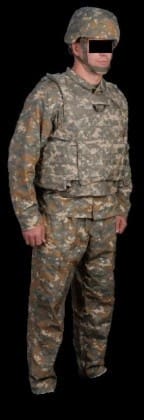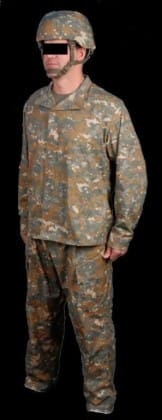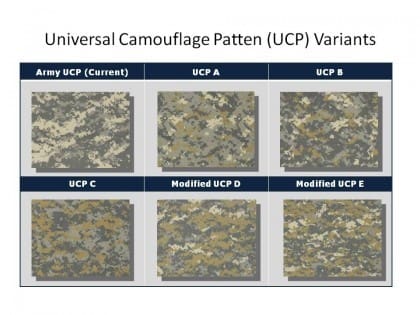Camo for Afghanistan – The Rest of the Story
On Friday September 18th, Soldier Systems Daily was granted an exclusive interview with PEO-Soldier’s COL William Cole, Project Manager Soldier Protection and Individual Equipment, Todd Wendt, Deputy Product Manager Soldier Clothing and Individual Equipment, and Cheryl Stewardson, Team Leader, Soldier Integrated Protection, at the U.S. Army Natick Soldier Research, Development & Engineering Center. The topic of our conversation was alternative camouflage patterns. Our goal at SSD for the interview was to cut through the misinformation and conjecture currently permeating the web on this subject and get to the facts. Up to now no one, including us, has adequately told the story of what is actually going on.
As a result of a photosimulation study conducted in 2007 by Natick as well as recent Congressional language directing the Army to provide an enhanced camouflage capability for Soldiers on operations in Afghanistan, the Army is undertaking a four-phased initiative to explore alternate camouflage patterns for the Army Combat Uniform (ACU). Additionally, the Army regularly conducts post combat surveys and had noted several comments that Soldiers were most dissatisfied with UCP’s performance in Woodland environments. Based on this information, the Infantry School suggested that perhaps a Brown shade should be added to the UCP color palette.
The Army’s objective is twofold: to identify an ACU camouflage that will provide effective concealment for Soldiers serving in Operation Enduring Freedom, and to evaluate a long-term camouflage plan for the Army. When COL Cole made his initial decisions on developing a course of action one of the main considerations was Fire Resistance. Whatever was going to be tested and fielded had to be FR. Additionally, they had to meet military specifications for infrared identification and be Berry compliant. Two patterns that met these specifications were readily available; MultiCam® and the Army’s Universal Camouflage Pattern. Recently, many have called for the complete elimination of UCP yet touted the performance of MARPAT. As we will discuss later, the patterns are the same, just with different pigments. If MARPAT performs well, UCP could be tweaked in order to enhance its characteristics and that is exactly what the Army did.
In conjunction with this interview, SSD was provided an exclusive look at the five alternative patterns named UCP-Alpha through Echo developed for the wear test.
Oddly enough, immediately after the story broke, strange conclusions began to surface around the internet that there was a significance to the UCP-Delta moniker. We can assure you that the Delta designation denotes no affiliation to any particular unit but rather is the phonetic alphabet for the letter D. PEO-Soldier used the alphabet since they were not sure initially how many variants they would need to work on. As it turns out, due to time constraints and some solid rudimentary research, they only produced five patterns. Of the five, only Charlie and Delta showed significant promise for further testing. Initially patterns were developed in .jpg format and then fabric was printed on a dot matrix printer.
According to Cheryl Stewardson, Natick researchers then conducted a modified photosimulation test similar to the one conducted in 2007. However, in this test 200 Soldiers at Forts Hood and Campbell with recent combat experience in Afghanistan were shown images of Afghani terrain that had been altered by superimposing photos of ACUs in the Charlie and Delta variants on them. During this testing, UCP-Delta was selected as the most promising pattern.
Some interesting facts about the US digital patterns were revealed during this interview. The digital camouflage is printed using a screen process. MARPAT, UCP, and the AOR patterns all use the same screens. Current UCP utilizes only three of the four screens required to produce MARPAT and AOR but UCP-Delta will add the fourth screen to apply the Coyote to the pattern.


Photos courtesy of PEO-Soldier
Phase I By the end of September 2009, the Army will provide two alternate uniforms to designated battalions of Soldiers serving in Operation Enduring Freedom. The two alternate uniforms will utilize the MultiCam® and Universal Camouflage Pattern – Delta (UCP-D). The UCP-Delta pattern was derived from the standard UCP by reducing the Urban Grey and Sand colors, and adding Coyote Brown which constitutes 30% of the pattern.
One battalion will receive the MultiCam® uniform, while the other will receive the UCP-Delta uniform. In addition to their test uniforms and equipment both battalions will also be issued a full complement of standard UCP equipment. This will allow commanders to outfit their troops based on METT-TC. While PEO-Soldier plans to use the IOTV in standard UCP for this test, they will provide test forces with the Tactical Assault Platform in UCP-Delta. The TAPS is similar to a chest rig that attaches to the IOTV. Additionally, PEO-Soldier is fast tracking a UCP-Delta solution for the rear of the IOTV. The battalion outfitted in MultiCam® will receive a full complement of TA-50 in that pattern including IOTV, Plate Carrier, MOLLE, and TAP.
Phase II By the end of October 2009, the Army will begin collecting data in theater to measure the suitability of various camouflage patterns. This phase will include feedback from Soldiers in Operation Enduring Freedom; photosimulation of uniform colors and patterns, along with associated Operational Clothing and Individual Equipment (OCIE) such as body armor, helmets, and rucksacks, against a variety of backgrounds common to Afghanistan including foliage, high desert, and mountains; and a photographic study in theater. Specific emphasis will be placed on ensuring accurate RGB values. The Army will analyze the data throughout the collection period in preparation for Phase III.
The next round of Photo simulation studies will include six patterns. However, not all of the patterns have yet been released. COL Cole confirmed that UCP-Delta, MultiCam®, AOR-2 and a newly developed pattern based on the UCP pattern with an entirely new colorway will be tested. The new pattern retains the four screen process but replaces even UCP-Delta’s colors with a pallet based on a photometric study of Afghanistan.
Another goal of this photosimulation study is to measure the effects of a variety of field equipment colors including UCP, Coyote, Khaki, and Ranger Green have when used with different uniform patterns.
Phase III By the end of January 2010, Army leaders will make a decision whether or not to produce and field alternate uniforms and OCIE to selected units in specific regions of Operation Enduring Freedom.
Phase IV At a date to be determined, the Army will establish and evaluate a long-term plan for ACU camouflage. If a new pattern is selected, even for limited use in Afghanistan, it may very well promulgate throughout the Army if it is demonstrates improved camouflage traits.
Once again SSD would like to thank the folks at PEO-Soldier and Natick who made this interview possible.

















































































































